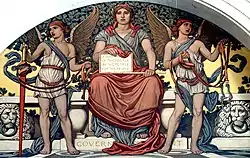| Public finance |
|---|
 |
A monetary hawk, or hawk for short, is someone who advocates keeping inflation low as the top priority in monetary policy. In contrast, a monetary dove is someone who emphasizes other issues, especially low unemployment, over low inflation.
The two terms are commonly used in the United States to describe members and nominees to the Federal Reserve Board of Governors, who have major influence on United States monetary policy in their roles as Federal Reserve Governors and as members of the Federal Open Market Committee.[1][2] The terms are also used outside of the United States, in places such as the United Kingdom[3] and India.[4] The term "pigeon" has been used to describe individuals who take positions between those of hawks and doves,[1] although the term "centrist" is also used.
Doves generally are more in favor of expansionary monetary policy, including low interest rates, while hawks tend to favor "tight" monetary policy. For example, doves in the United States tend to favor quantitative easing, seeing it as a way to stimulate the economy,[5] while hawks tend to oppose quantitative easing, seeing it as a distortion of asset markets.[1] Additionally, hawks tend to project higher future inflation, and hence see more risk from inflation and a greater need for tight monetary policies, while doves tend to predict lower future inflation, and hence see more need for expansionary monetary policies.[6]
An individual can be a hawk in some cases and a dove in others.[6] For example, Janet Yellen was described as a hawk during the economic boom of the 1990s, but was usually described as a dove when she was nominated to the position of Chair of the Federal Reserve.[7] Additionally, the label of "hawk" and "dove" may be applied differently depending on the point of view.[8]
The hawk–dove dichotomy has been criticized as overly simplistic, especially in times of deflation or low inflation. For example, Federal Reserve Bank of St. Louis President James Bullard has been described as a "deflation hawk" for favoring policies that would raise inflation to a target of 2 percent per year. Washington Post columnist Neil Irwin used the term "bubble hawk" to describe those who focus on using monetary policy to fight financial bubbles.[9]
See also
References
- 1 2 3 Gura, David (13 November 2013). "The economic shorthand of hawks and doves". Marketplace.org. Archived from the original on 13 March 2014. Retrieved 13 March 2014.
- ↑ Kawa, Lucas (10 January 2013). "HAWKS & DOVES: Meet The 12 People Who Will Control America's Monetary Policy In 2013". Business Insider. Retrieved 13 March 2014.
- ↑ "Bank of England MPC: Who sets UK interest rates?". BBC. 23 November 2011. Retrieved 13 March 2014.
- ↑ ET Bureau (29 January 2014). "RBI a vigilant owl, neither a dove, nor a hawk: Raghuram Rajan on monetary policy". The Economic Times. Retrieved 13 March 2014.
- ↑ GI (9 October 2013). "A new hand on the tiller". Economist. Retrieved 12 March 2014.
- 1 2 Duy, Tim (17 April 2012). "On Labels, Dove vs. Hawk". EconoMonitor. Retrieved 13 March 2014.
- ↑ O'Brien, Matthew (17 September 2013). "Fed Favorite Janet Yellen Is No Dove—and That's a Good Thing". The Atlantic. Retrieved 13 March 2014.
- ↑ RA (14 October 2013). "Of doves and dovishness". The Economist. Retrieved 13 March 2014.
- ↑ Irwin, Neil (30 July 2013). "Why we shouldn't think of central bankers as hawks and doves". Washington Post. Retrieved 13 March 2014.